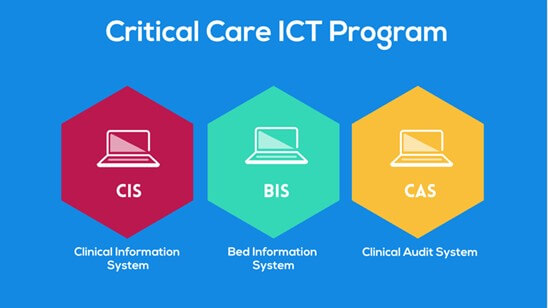Critical Care ICT Programme
The Critical Care ICT Programme was formed with the purpose of focusing and coordinating the activities of several interrelated and interdependent ICT projects to enhance their delivery and augment the benefits for patients and staff over time.
Current active projects under the remit of the Critical Care Programme include:
- Implement Critical Care Clinical Information Systems (CIS)
- Bed Information System
- Clinical Audit System
Implement Critical Care Clinical Information Systems (CIS)
Our Lady of Lourdes, Drogheda
Saolta University Healthcare Group, which includes:
- Sligo University Hospital (Upgrade and Migration)
- Mayo University Hospital
- Portiuncula University Hospital
- Letterkenny University Hospital
Model 3 and 4 Hospitals that do not currently have a Critical Care CIS – circa 13 sites
In Collaboration with the National Office of Clinical Audit (NOCA):
Bed Information System (BIS)
- System Enhancements 2020
Clinical Audit System (CAS)
- National Critical Care Database
- ICNARC Dataset Upgrade

* The Critical Care ICT Programme also provides Project Management support to partners in NOCA to deliver the Irish National Orthopaedic Register (INOR).
Our Critical Care services save lives and work with the most seriously ill people in the country. Patients in Critical Care settings have needs due to the critical nature of their illness. Medical care in the Critical Care Units is provided by Anaesthetists or Intensivists. Nursing care is provided by specially trained nurses on a one to one or two to one basis 24 hours a day. Health and social care professionals are part of this care giver group also. In addition to the high level of medical, nursing and allied healthcare professional care provided in this setting, it is a highly technical environment with a wide range of highly specialised medical devices at each bed space.
The availability of good clinical information on each site and across sites helps to optimise care and the safety of the care provided. Within legacy Critical Care processes, a lot of manual data is generated that must be stored centrally to facilitate access by the care teams. This creates bulky paper files that are difficult to share, can be mislaid, and are time-consuming to search for relevant information. Manual data collection and transcribing are also prone to transcription errors.
To overcome these difficulties, there is a need to introduce the latest technology available to make Critical Care a paper-light environment that can integrate all the bedside devices and hospital-wide health systems interacting with Critical Care; including patient administration, imaging and diagnostic, laboratory, pharmacy and prescribing, bed information and clinical audit.
In the critical care environment with high density clinical data points and complex patients, a Clinical Information System (CIS) can facilitate data processing and display, automate routine patient care tasks, augment clinical decision making and improve patient safety. A key benefit from installation of a CIS is a continuous and integrated electronic patient record which can be used by all members of the wider multidisciplinary team caring for the patient.
